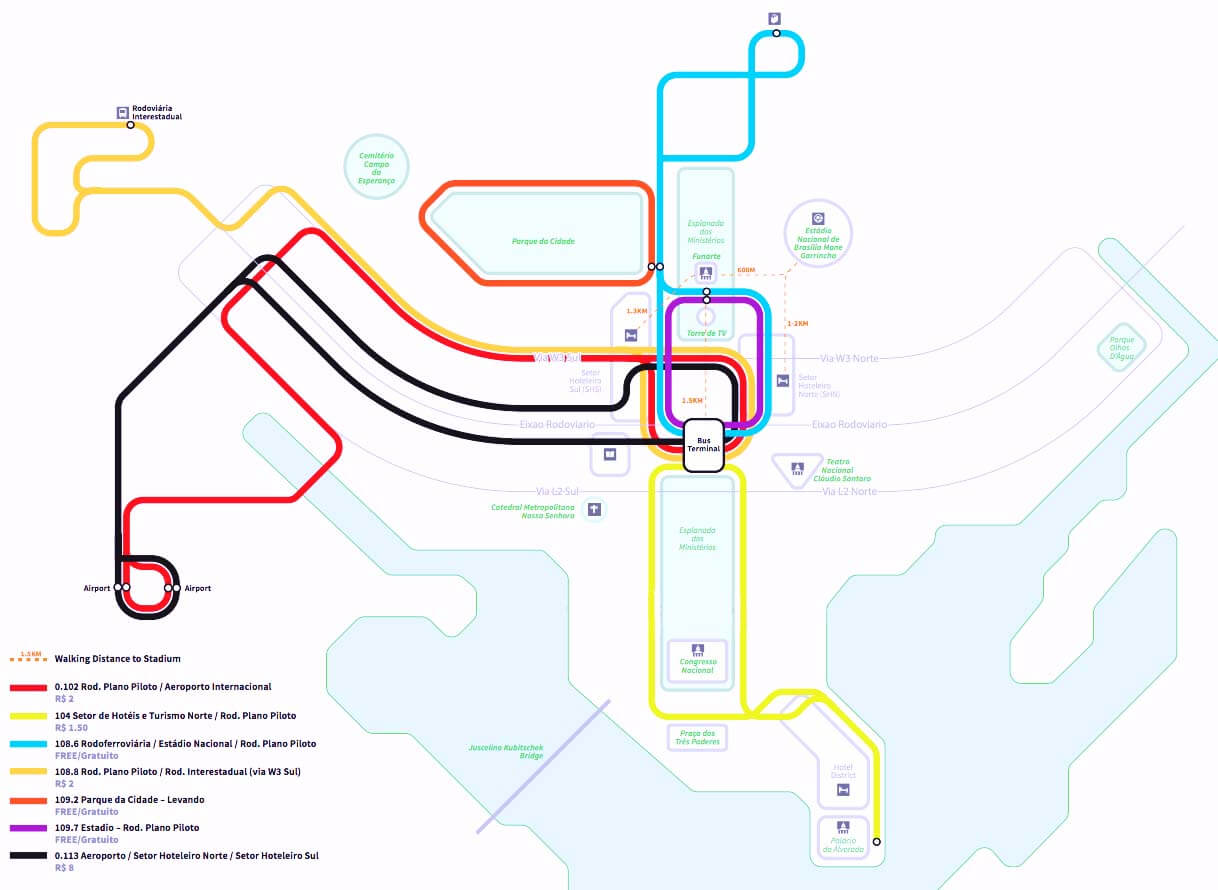Brasilia City and its Layout
As the capital of the South American nation of Brazil, Brasilia sees a large influx of lobbyists and sightseers every day. The city has been built in a very rational way, with two roads dividing the city and creating its characteristic bow and arrow image. The Eixo Monumental runs from east to west, with all the government buildings and monuments along its route. It divides the city into two different wings, the Asa Sul (South Wing) and the Asa Norte (North Wing).
The Eixo Rodoviario, on the other hand, runs with a slight curve in a north-south direction. The central bus station, or Rodoviaria, is the intersection of these two streets. The city is further divided by the zoning of the different areas: while most of the hotels are located around the Rodoviaria, all the government buildings are along the Eixo Monumental, mainly at its eastern end.
Public Tansportation Map
Map of Public Tansportation in Brasilia showing different lines and stations. Click on the map to enlarge it.
Public Tansportation in Brasilia
The public transport system in the city is not as good as many might expect. However, it is still better compared to some of the other cities in Brazil, simply because the rules and laws governing the traffic situation in the city are strict. Let’s take a look at the public transport options in Brasilia that tourists can use to get around the city.
Brasilia Metro
The Brasilia Metro, in the shape of a Y, is served by two lines. They do not run through most of the political or tourist areas, so it is not convenient to use the metro for a sightseeing tour of Brasilia. Not as extensive as the metro services in some other cities, Brasilia’s metro service starts at the Rodoviaria bus station and heads south. It was built mainly to serve the huge population living in the region’s satellite towns. The satellite towns are more densely populated than the pilot plan of Brasilia, and people rely heavily on the metro service, which is clean, safe, fast, and also free from any form of congestion caused by road traffic.
Taxis in Brasilia
With a reasonably comfortable, safe and comprehensive bus system in the city, you really do not need a taxi for your travels. Taxis in the city are generally more expensive than in other Brazilian cities. The city blocks are larger than usual and distances are longer than you might think. Very often you will have to make detours and loops to reach a particular building within a block. Taxi drivers in the city are known to take advantage of this traffic pattern, as taking a slightly different route can add significantly to your fare. Note that the traffic plan is such that you cannot easily get back on the correct route. If you must take a taxi, it is best to call a radio taxi, as they offer discounts of around thirty to forty percent for each trip. As most taxis in the city have a radio, it won’t take long for one to reach you. They are also safer than others because the radio makes it easier for you to call for help. You may want to ask your hotel to book a taxi for you, as trying to catch one on the street will be futile.
Bus services in Brasilia
The bus is the best choice among all the public transport in Brasilia. You can get excellent access to the city centre and its neighbourhoods by making the most of this bus system. Note that unless you flag down a bus, it will only stop at a bus stop if there is a passenger waiting to get off. Rodoviaria, located in the centre of the city, is the main bus terminal and is the point of departure for most buses, regardless of their route. Even if they do not originate from here, most buses pass through here, so there is no need to look elsewhere to find a bus to your destination. The red and white minibuses, known as zebrinha, are the preferred choice. If you want to get around the city, they are extremely useful as they connect the central districts of Brasilia to some of the city’s main areas, such as the airport, Esplanada dos Ministerios and other major avenues.
Getting around in Brasilia
While most other Brazilian cities can be effectively explored on foot, Brasilia is not particularly pedestrian-friendly. Nevertheless, you can easily navigate the central districts on foot. However, you may find the lack of shade and the ridiculous heat of the midday sun overwhelming, in which case you should consider using buses, taxis and other forms of public transport in Brasilia.
